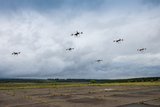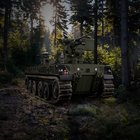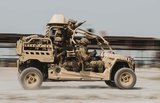US Army Unmanned Aircraft Systems Project Office: 2010 Planned Enhancements; 2009 Accomplishments
Just in time for the next surge into Afghanistan, the Army's Unmanned Aircraft Systems (UAS) Project Office, headquartered at Redstone Arsenal, Ala., will provide a variety of improvements to existing systems, as well as field the latest most advanced UAS available.
"The mission of the UAS Project Office is focused on the Warfighter; we are here to provide our Nation and allies world class systems that are interoperable and affordable, and we do that through excellence in our program management," said Col. Gregory B. Gonzalez, Project Manager, Unmanned Aircraft Systems. "We work through our Training and Doctrine Command partners to accept feedback directly from our Soldier/Operators and Commanders in the field to develop and field the enhancements that will help them complete their missions more efficiently and effectively. We are excited about the new technologies we will deliver throughout 2010."
The upcoming improvements underway or planned for existing Army UAS during Fiscal Year 2010 include:
• Extended Range/Multi-Purpose (ER/MP) system Milestone C, the decision to move into Low Rate Initial Production
• ER/MP Quick Reaction Capability-2 (QRC-2), live flight testing of the new weaponized aircraft by the operators in training, followed by a Limited Users Test and eventual deployment - deployment will include 4 aircraft and 2 Ground Control Systems; QRC-2 systems are capable of carrying and launching up to four HELLFIRE® P+ missiles
• Shadow® Tactical UAS upgrades to include a laser designator, enhanced fuel injection system, and longer wings for carrying heavier payloads such as a Tactical Common Data Link (TCDL)
• Warrior Block 0 to receive a 2.0 liter heavy fuel engine, an upgrade from the current 1.7 liter engine, as well as secure voice communication and an encrypted satellite communications data link
• Hunter Tactical UAS and Raven Small UAS to be integrated with the One System® Remote Video Terminal (OSRVT)
• OSRVT to be integrated into the OH-58 Kiowa Warrior helicopter fleet for manned-unmanned team as it is with the AH-64 Apache fleet
• First production models of Rover 6 for OSRVT are due, adding bi-directional capability and encryption not available in the currently-used Rover 4
• Shadow and Hunter systems to be upgraded with the Type Two Interim Encryption System (TIES) for encrypted video downlinks
• Integrate the Digital Data Link (DDL) into Gasoline Micro Air Vehicle (gMAV), Class I system, and OSRVT
• Raven Small UAS to be retrofitted with an improved motor and propeller for high altitude operations
• Small UAS Proof of Principle Soldier unit selected for a one year evaluation of a "family" of systems, including evaluation in a combat area, to address RSTA shortfalls at the Platoon and Battalion levels; family would include 3 small UAS: a Raven, one vehicle smaller than a Raven and one larger,
• Class I Block 0 Heavy Fuel Engine propulsion testing in preparation of the Critical Design Review
• Testing new technologies such as Type Two Interim Encryption System; Heterogeneous Airborne Reconnaissance, Surveillance, & Target Acquisition (RSTA) Teams (HART), a DARPA project designed to shorten tasking, re-tasking and sensor-to-shooter timelines; the Special Operations Payload System (SOPS) for the Special Operations Command (SOCOM) providing a classified capability with the Shadow system; and Corporal, a technology providing limited electronic attack and RSTA networking capability using Shadow
The groundwork for these upcoming improvements was laid during 2009, a year that featured an endless supply of enhancements and milestones, all designed to improve mission success for the Warfighter. During Fiscal Year 2009, total Army UAS hours flown was 940,037.9, with 88-percent, or 782,658.8 hours flown in support of Operations Iraqi Freedom (OIF) and Enduring Freedom (OEF). The total monthly flight hours now averages 20,175.9.
The Project Office's most significant accomplishments during Fiscal Year 2009 include:
• Opened the UAS Rapid Integration and Acceptance Center at Dugway Proving Ground to consolidate the testing of payloads and technologies to allow for faster deployment to Warfighters
• Established a product directorate to serve as the Department of Defense's leading office working on ground based sense-and-avoid technologies that will safely allow UAS to fly in the national airspace
• Deployed to Iraq the first quick reaction capability (QRC-1) ER/MP which utilizes satellite communications for RSTA activities over long distances and mountainous areas
• Completed a successful series of HELLFIRE P+ missile firings from the ER/MP UAS QRC-2 that will deploy in late summer 2010
• Converted the first Raven small UAS from an analog to a Digital Data Link, with encryption capabilities, allowing up to 16 Ravens to fly in the same area safely
• Retired the I-GNAT UAS after 5 years and 40,000 flight hours in combat
• Achieved 50,000 combat flight hours with the Sky Warrior Alpha in just three years
• Integrated and fielded HELLFIRE missile systems on the Warrior Alpha UAS in support of OEF
• Fielded four Hunter systems with TCDL in support of OEF, providing an increase in data transfer capabilities; also included an upgrade to signals intelligence payloads
• Completed a successful limited users test of the Class I Block 0 UAS
• Fielded an Improved parachute on the Shadow tactical UAS
• Fielded a new oil pump and cold weather oil on Shadow tactical UAS
• Set a new Raven B flight endurance record of 120 minutes, an increase from 100 minutes
• Upgraded the OSRVT with new encryption technologies
• Integrated the OSRVT with the ER/MP QRC-1 in combat areas
• Upgraded the OSRVT with an interim encryption system; fielding to continue into 2010
• Increased the quantity of OSRVT fieldings per month for a total of 2,000+ systems fielded to-date
• Fielded a Small UAS kit for proof-of-concept testing that includes a Raven and two other UAS - one smaller and one larger than the Raven
Source: PEO Aviation
More from Uncrewed Vehicles
-
![Ready for the race: Air separation drone swarms vs. air defence systems]()
Ready for the race: Air separation drone swarms vs. air defence systems
As the dynamics of aerial combat rapidly evolve, Chinese scientists have engineered a sophisticated air separation drone model that can fragment into up to six drones, each capable of executing distinct battlefield roles and challenging the efficacy of current anti-drone defences such as the UK’s Dragonfire laser system.
-
![Israel’s MALE UAVs ‘must adapt’ to Iranian-made air defences]()
Israel’s MALE UAVs ‘must adapt’ to Iranian-made air defences
Advancements in air defence technologies have begun to reshape aerial combat dynamics in the Middle East, as illustrated by recent events involving the Israeli Air Force and Hezbollah.
-
![Hundreds more UAS sent to Ukraine forces with thousands more on the way]()
Hundreds more UAS sent to Ukraine forces with thousands more on the way
Both sides of the Russia-Ukraine war have been using UAS for effective low-cost attacks, as well as impactful web and social media footage. Thousands more have now been committed to Ukrainian forces.
-
![AI and software companies selected for US Army Robotic Combat Vehicle subsystems]()
AI and software companies selected for US Army Robotic Combat Vehicle subsystems
The US Army has intentions to develop light, medium and heavy variants of the Robotic Combat Vehicle (RCV) as part of the branche’s Next Generation Combat Vehicle family.
-
![DroneShield to improve software of DroneSentry-X C-UAS system under new contract]()
DroneShield to improve software of DroneSentry-X C-UAS system under new contract
DroneSentry-X, a cross-vehicle compatible, automated 360° C-UAS detect and defeat device, can offer 360° awareness and protection using integrated sensors. According to its manufacturer, it is suitable for mobile operations, on-site surveillance and on-the-move missions.
-
![Ukraine takes delivery of new indigenous C-UAS systems]()
Ukraine takes delivery of new indigenous C-UAS systems
Funded by the country’s former president, the new C-UAS systems will be sent to the frontline where they have already been tested against Russian invading forces.


























